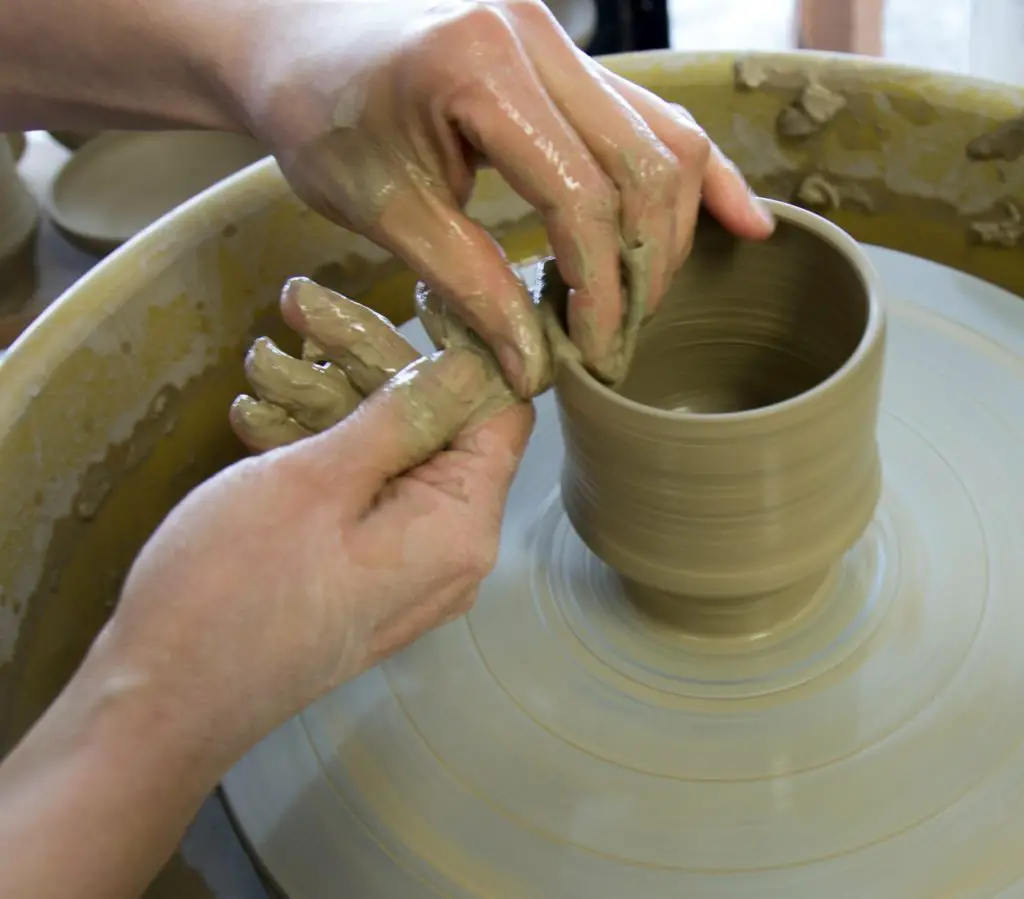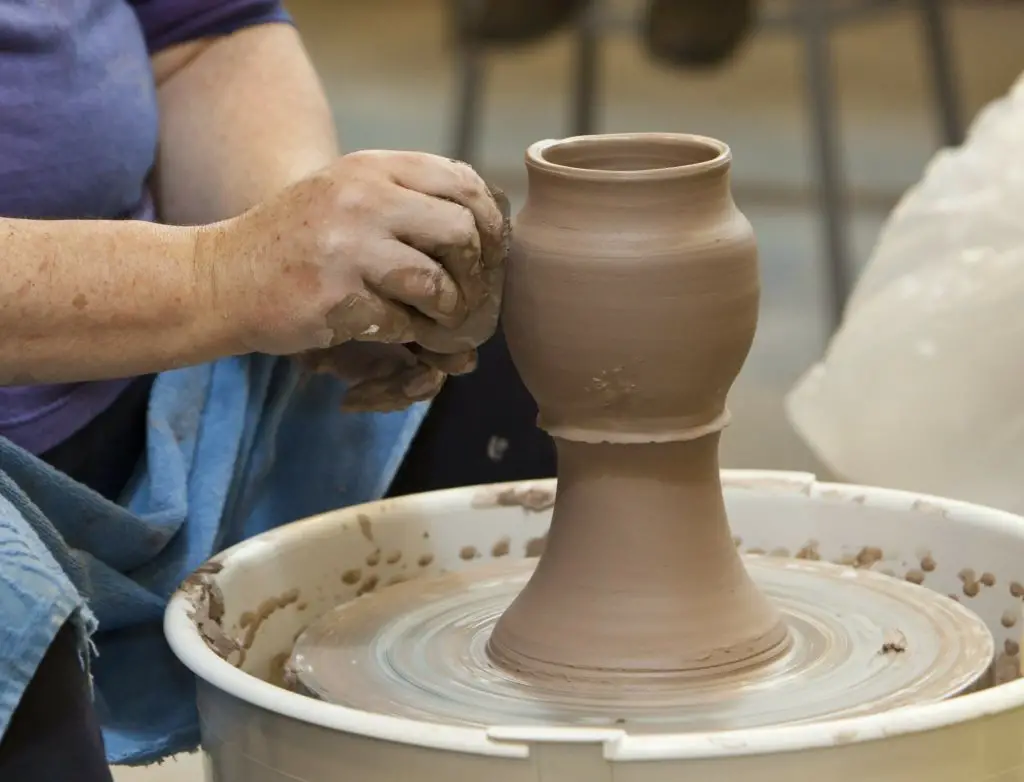Throwing tall cylinders isn’t easy to accomplish, and it does take both time and skill to learn how to do this. Fortunately, you can learn pretty easily, and here, we’ll tackle the main issues that come with tall cylinders, and why you must know how to do this.
There are many problems with throwing tall cylinders and how to fix them that you should know about, and here, we’ll tackle what these are, and why it is important to know how to fix these issues as they crop up.
The Pulls Ruining the Pottery
This is a common problem when you start to work on the walls and pull it. That is because these later pulls create the following problem:
- The walls get too thin
- They collapse on one another
The solution to fix this problem is actually quite simple, and that is the following:
- Slow down the wheel
- Make sure your clay is properly wedged
- Only do three or four pulls maximum, and if you do more, it will cause the cylinder to be shorter
- Pay attention to your pulls, and don’t hesitate to do a “half pull” to help fix the problem
Usually, it can be easier with time, but you should definitely watch how you are pulling the clay, since it can be quite frustrating when you begin, and you should make sure that you take your time with this.

The Clay is Uneven
This is usually a problem when you start to build the walls of your pottery piece, but usually, this can be fixed with a few easy steps. You could do the following:
- Steady yourself
- Make sure that your neck, shoulders, arms, and palms are rigid
- When forming the walls, make sure you’re using equal pressuresBrace your arms and body against your legs
- Try to aim for using your entire body, and not just your hands and arms
The more you get your body into the actions of pulling, the easier it will be, and when you’re making tall cylinders, you want to make sure that you have a good feel for this, and that you’re using the proper placement of your body since you are working with a taller structure.
Your Walls Are Too Thin
This usually happens because you’re using too little clay. The truth is, when you’re working with tall cylinders, you want to make sure you’re not shirking on the amount of clay.
The problem with people using only a certain amount of clay, or a singular ball, is it creates the following:
- The bottom is too thick
- The upper walls get thin
- You will need a lot of trim to fully refine this
- It makes it much less delicate and is liable to collapse
Some people think that throwing one form in one go is the best idea, but that can be quite cumbersome. You shouldn’t just use one singular form because of the following:
- It takes a long time
- It will kill your hands
- It will require a lot of trimming
- It makes the pottery look super ugly
So you want to throw these large forms, right? Well, how do you do it?
The answer is actually super simple, and that is in sections.
To do this, you must do the following:
- Take one section, throw a little bit of it
- You can then work the walls up
- Slowly make sure the bottom thins itself out
- Add more clay as needed
- Don’t work with some giant 43-pound ball of clay ever
- Pull one section then work on the next section, don’t try to do it all at once
This is especially important since you are working with larger forms, and if you have to do a lot of pulling, it will tire out your hand and make the piece look terrible. Save your pottery, and save your hands by making sure that you throw this in time, and also make sure that you don’t overwork this.
You’re Having Trouble Balancing the Sides
This is something that comes with practice, and it is a common issue that a lot of people tend to struggle with.
Lots of people won’t throw thicker but instead will try to stretch it out, but instead, they make the walls paper-thin and uneven, which is a big problem.
What you need to do, is sit around and learn, and that involves doing the following:
- Work on throwing the form in a tall manner first
- From there, work on trying to thin out the form as well
- Start to slowly combine these
- Start to work on the form, and see your form in this
- Make sure that you’re working on trying to get it as uniform as possible.
If you are having any trouble whatsoever in throwing tall forms, especially when it comes to the balance of both of these, you should work to try and balance out both of these different factors. That way, you should be able to handle all of this, and it will allow you to throw the pieces well and create some wonderful items that you can use.
Wall Issues
This is another big problem that comes with throwing cylinders in particular, because this can be quite frustrating to deal with. Here, we’ll talk about how you can fix every single wall issue that happens when you throw these cylinders.
First, is the wall collapse. This usually shows itself in the following manner:
- One wall just falls in itself
- Both walls fall, whether it be under pressure or otherwise
This is actually pretty simple to rectify and to fix this, you must do the following:
- Use as little water as you can
- Always move the hands up to the bottom and then to the top
- Never move top to bottom or press downwards
- Try not to take too long to center and throw the piece
- You should realize that the more pull you do, the softer it gets, so limit the pulls you’re doing
Next, you’ve got the off-center wall, which happens commonly when you’re trying to improve the walls, but then one of them ends up being thinner than the other, or not correctly evened out.
The solution to this is to do the following:
- Put slightly more pressure on the inner and outer parts of your hands and fingertips, between 4 and 3 o’clock, and move them upwards in an even manner
- Keep doing this with your hands together
- Gently press on this, and don’t be too forceful
Usually, you want to make sure that wall isn’t lumpy or off-center for a few reasons, and that includes the following:
- When it fires, it can crack the wall
- It can make the piece look better
- Helps to maintain evenness
Finally, you’ve got the air bubbles, which can sometimes happen when you’re working with this, and a result of the movement of the clay.
To fix this, you need to do the following:
- Stop your wheel
- Poke the wall
- Fill the void that’s left with clay
- Throw the wall once again
- You can prevent this by wedging the clay and then coning it several times
Usually, this is preventable by gently moving the wheel about and making sure you apply the right pressure.
The walls are Not As thin and Even as they should be
This usually happens at the end, when you look at your piece and realize that it can be thinner, and evener. The solution to this is to just change a few things that you do.
To fix this, do the following:
- Thin it and grow the wall after you collar it
- Use a throwing stick to help with this
- Use just your fingertips, and get rid of any excess torque
- Use a sponge to help remove the water, and a rib to scrape down the bottom of this Use one finger in the hole too to help even it out, especially if you’re creating narrow, thin cylinders
This can take a bit of practice, but with some mastering, it can help.
Your bottom is Gone!
This usually happens when you’re throwing something very tall, and you notice that it’s not there anymore. What happens is the following:
- Your fingers pushed too fast or too hard
- This then pulls the bottom out
There are a few ways to fix this, and you can do the following:
- Stop the wheel, smooth this out, and re-throw
- Stop opening to the bottom of the thicker side
- Check the thickness with the needle to measure, and you can push it down further to thicken it
For some people, stopping and re-throwing might be the beginner’s solution, but you can fix this with the proper steps, and you can fix it whenever you need it.
Your opening hole is uneven or Off-Center
This is usually what happens when you first open this, and the best way to fix this is to do the following:
- Take your left middle finger or the tip of it, and from here move the tip of the left thumb together to push straight down toward the center
- Open the flat with your fingers or thumb
- Press down and move to the middle instead of picking this in the middle
- Continue to make a hole big enough for multiple fingers
Usually, this will help you, and if you need to, slowly work the centering of this, so that you can have the best, and most worthwhile pottery experience that you can have, and the right results that you hope to accomplish.
The Triangle Bottom
This is another big problem, and usually, it comes from the walls being very thick and pointy. The best way to fix this is to do the following:
- Create a flat bottom
- First, open up the centered clay
- Push the fingers into the hole and pull it across the bottom
- Then pull this up again.
This is commonly done in parts, and you can do this even if most of the piece is thrown already.
The Shape isn’t Matching
Finally, you may have issues with the shape of the cylinder, and this usu usually a bit of a more involved process to fix.
To fix it, you must do the following:
- Throw this first
- Get the height that you want afterward
- If you notice that the inside is not matching, you will want to thin these areas out a little bit
- Slowly work on these, moving upwards
- If they do have an uneven texture to them, it causes cracking, blowing up during a firing process, and just poor feel, balance, and weight problems
For many people who throw pottery, you’ll notice that these tips are relatively easy to follow and you should just take your time to master the art of throwing cylinders.
Cylinder Mastery
For many people, throwing cylinders takes a bit of time and practice, and it can be a bit of a process. But, it allows for you to throw some wonderful objects, and in turn, you’ll be able to, with this as well, create a much better cylinder than you have had before, and it can help you master all of this too.

With the right technique and the right actions, you can master all of this, and in turn, make it even better for you.
If you do have issues with throwing cylinders, see if there is something that you can do, and you’ll be able to, with this as well, create the best shapes possible.







